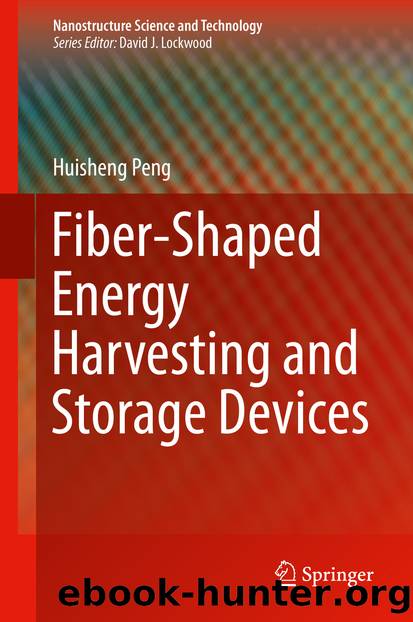Fiber-Shaped Energy Harvesting and Storage Devices by Huisheng Peng

Author:Huisheng Peng
Language: eng
Format: epub
Publisher: Springer Berlin Heidelberg, Berlin, Heidelberg
5.1.1 Working Mechanism
Many apparently different types of solar cells actually share two common processes during work: light absorption to create electron-hole pairs and charge separation to generate photovoltage and photocurrent. The light absorbers, in general, are photosensitive semiconductors, which classify the solar cells into different categories: sensitized solar cell, polymer solar cell, and, here, perovskite solar cell. The charge separation, which takes place at a contact interphase that is selective for electrons or holes, dictates the energy available inside the device. In a traditional p-i-n solar cell, p-type and n-type semiconductors are selective for holes and electrons, respectively, while in DSC and PSC, the selection is conducted by different electron and hole conductors, and likewise in perovskite.
Particularly in perovskite solar cells, the light is harvested by the perovskite like CH3NH3PbI3 that has a bandgap of 1.55 eV, lower than the semiconducting polymers (~2 eV) and inorganic semiconductors (~3.2 eV), thus promising a broad spectral sensitivity with onset of 800 nm. The strong light absorption of the perovskite enables an outstanding performance of the solar cell since it moderates the requirement for film thickness and facilitates the charge collection. The photoinduced excitons after light absorption have small binding energy (30‒75 meV) that suffices for thermal dissociation into free carriers (electrons and holes). It has been proved that the excited perovskite is mainly populated by free carriers rather than their associated pairs [12]. Then, the free carriers transport through the electron conductors and hole conductors, respectively, and get collected at electrodes.
As illustrated in Fig. 5.2, there are seven processes involved in the illuminated perovskite solar cell: photoexcitation (1), electron transfer to ETM (2), and hole transfer to HTM (3); (4) to (7) represent the unwanted recombination process including the reassociation of free carriers (4), back transfer from ETM and HTM to perovskite (5) and (6), and local short circuit at the absent of perovskite (7). For perovskite solar cell, one of their advantages over DSC and PSC is the long carrier-diffusion length (102‒103 nm) which contributes to a low non-radiative recombination [11].
Fig. 5.2Schematic diagram of energy levels and electron transfer process in an HTM/perovskite/ETM cell
Download
This site does not store any files on its server. We only index and link to content provided by other sites. Please contact the content providers to delete copyright contents if any and email us, we'll remove relevant links or contents immediately.
Alchemy and Alchemists by C. J. S. Thompson(2909)
The Elements by Theodore Gray(2428)
The Club by A.L. Brooks(2352)
How to Make Your Own Soap by Sally Hornsey(2335)
Drugs Unlimited by Mike Power(2189)
Wheels of Life by Anodea Judith(1605)
Cracking the Sat French Subject Test, 2013-2014 Edition by The Princeton Review(1518)
The Cosmic Machine: The Science That Runs Our Universe and the Story Behind It by Scott Bembenek(1478)
Perfume by Jean-Claude Ellena(1466)
The Flavor Matrix by James Briscione(1360)
1000 Multiple-Choice Questions in Organic Chemistry by Organic Chemistry Academy(1349)
Cracking the LSAT, 2012 Edition by Princeton Review(1338)
MCAT Physics and Math Review by Princeton Review(1302)
Cracking the SAT Premium Edition with 6 Practice Tests, 2017 by Princeton Review(1250)
Synchrotron Light Sources and Free-Electron Lasers by Eberhard J. Jaeschke Shaukat Khan Jochen R. Schneider & Jerome B. Hastings(1234)
Handbook of Modern Sensors by Jacob Fraden(1221)
A is for Arsenic: The Poisons of Agatha Christie (Bloomsbury Sigma) by Kathryn Harkup(1211)
Harry Potter All Books: 8 Books by J.k.rowling(1186)
Cracking the AP English Language & Composition Exam, 2018 Edition by Princeton Review(1032)
